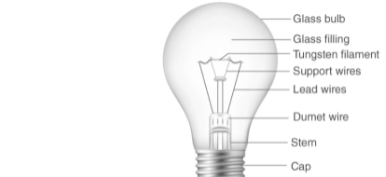Inventors started working on a brilliant idea that would change the way we utilise energy in our homes and offices more than 150 years ago. This idea revolutionised building design, lengthened the normal workday, and sparked the creation of new enterprises. It also resulted in new energy innovations, ranging from power plants and transmission lines to household products and electric motors.
The light bulb, like many great innovations, cannot be attributed to a single person. The light bulbs we use in our homes today are the result of a series of incremental refinements on previous inventors’ ideas.
Electronic bulb
The electronic bulb is the most basic electrical lamp, having been designed more than a century ago for illumination. The dark space was lightened by a little and simple light. The light bulb is another name for an electronic bulb. Thomas Alva Edison began working on a viable incandescent light in 1878, and the electronic bulb was invented in 1879. On October 14, 1878, Edison filed a patent application for “Improvement in Electric Lights.”
An incandescent lamp, incandescent light globe, or incandescent light bulb is another name for an electrical bulb. The bulb is available in a variety of sizes and light outputs, and it runs on a voltage range of 1.5 to 300 volts.
People utilised candles, gas lights, oil lamps, and fires until electric illumination became popular in the early twentieth century. Humphry Davy, an English chemist, invented the first incandescent light in 1802, and the first practical electric arc light in 1806. Davy’s arc lamp had been commercialised by the 1870s and was used to illuminate numerous public locations. [5] Commercial incandescent light bulbs became widely available in the 1880s thanks to efforts by Joseph Swan and Thomas Edison, and by the early twentieth century, they had totally supplanted arc lamps.
Working principle of incandescent bulb
The light bulb works on a relatively simple principle: an electric current is passed through a tiny filament, causing it to heat up. The bulb shines because hot items often emit light. The higher the temperature, the brighter the bulb glows and the “whiter” the light that is produced. So, we can claim that if we heat the filament sufficiently, we will get a strong source of light with wavelengths spanning the entire visible spectrum.
Construction of a light bulb
A modest and simple light source, an electronic bulb employs a wire filament to illuminate when electricity is applied. Incandescent light bulbs have the structure indicated in the diagram below.µ

The light bulb is made up of three main components.
- The filament,
- The bulb made of glass, and
- The light bulb’s base
Tungsten is used to make the filament, which is a coiled thin wire. Tungsten was chosen as the filament because of its high melting point, which prevents the filament from melting at high temperatures.
The filament is contained within a globe-shaped glass mount and is connected to the lamp’s base through copper and lead wires. The wires and filament are contained within a glass bulb filled with an inert gas such as argon. Because argon is a non-combustible gas, it protects the filament from burning and extends its lifespan. The bulb is made of thin glass that prevents air from reaching the filament and so protects it from burning.
When electricity is transmitted through the bulb, it travels through copper and lead wires to the filament. The bulb is held upright by the base, which also links to the electric circuit.
The power passes from the bottom to the tungsten filament by copper and lead wires. It causes the bulb to glow and emit light.
Pros and cons of electronic bulb
Pros:
- Bulbs have a longer lifespan than any other type of light.
- Working time varies between 8000 and 15000 hours.
- It is both inexpensive and cost-effective.
- It is simple to set up.
- It is available in a variety of sizes and shapes.
- Produces a large amount of output.
Cons:
- It is inefficient in terms of energy usage.
- A normal lamp lifetime is around 1000 hours.
- It emits a warm glow.
- Higher running costs are required.
- It is fragile because it is made of glass and should be treated with care.
- The bulb produces a low number of lumens per watt.
Power consumption of incandescent bulb
Electricity goes through a filament in an incandescent bulb, which heats up to the point of producing light. Approximately 95% of the energy is wasted as heat, with only 5% going toward light.
Conclusion
When an electrical current flows through the metal filament wire of a light bulb, it heats it to a high temperature till it lights. A glass bulb filled with inert gas protects the hot filament from the air.
 Profile
Profile Settings
Settings Refer your friends
Refer your friends Sign out
Sign out




